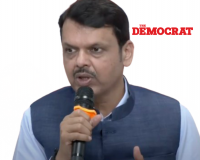- Editorial
- Less Agriculture, More Starvation
Less Agriculture, More Starvation
As the global population continues to rise, agricultural land is shrinking. With increased use of land for infrastructure and buildings, agriculture is suffering the adverse impacts of global climate change. Continuous cultivation of the same crops has led to a decline in per-acre productivity. In such a scenario, feeding such a vast population becomes a serious concern, and the increasing number of deaths due to hunger around the world is alarming.

By Bhaga Warkhade
According to the United Nations Population Fund’s State of World Population Report, India has now become the most populous country in the world. The global population is growing at such a rapid pace that the strain on natural resources is becoming increasingly evident. This poses a major challenge. Additionally, displacement is emerging as a serious global issue, as growing populations are forcing people to seek basic necessities in other countries. Today, the twin challenges of increasing population and depleting resources form a complex crisis for the entire world. Resource growth is now limited in proportion to population growth. Asia alone accounts for 61% of the world’s population. Thus, our Earth, which is burdened with nearly 8 billion people, is looking for solutions to many problems caused by this population explosion. Currently, India accounts for 18% of the world's population but holds only 2.5% of the world’s land and around 4% of its water resources. In this situation, the rapidly growing population could become a social and economic threat to the country. Population growth is at the root of many problems today. Poverty, malnutrition, unemployment, inadequate healthcare, rising crime, and the lack of clean drinking water are all directly linked to population growth.
It is estimated that although 60% of India's land is used for agriculture, around 200 million people still do not get two meals a day. Problems arising from the shortage of resources due to the population explosion are affecting everyone. At the same time, considering the current pace of population growth, ensuring that everyone gets enough to eat in the coming years is a pressing concern. Climate change threatens not just livelihoods, water supply, and human health, but also poses serious risks to food security. Food security is now one of the most pressing issues facing most countries, as agricultural land continues to be encroached upon due to urban expansion. In essence, while the number of people to feed is rising, the land available for farming is decreasing. In such a situation, ensuring food from agriculture for all will be a new challenge.
In India, more and more farmers are stepping away from agriculture, which may worsen the food security crisis. The decline in cultivable land is also impacting the socio-economic structure of the country. The government has taken some successful initiatives to convert barren land into arable land. However, the amount of cultivable land in India has been decreasing year after year.
According to the Wasteland Atlas report, agricultural states like Punjab have lost 14,000 hectares of cultivable land, while West Bengal has lost 62,000 hectares. In the highly populated state of Uttar Pradesh, the situation is even more alarming, with 48,000 hectares of farmland lost annually due to development projects. It is noteworthy that in 1992, rural households in India had access to 117 million hectares of land, which decreased to just 92 million hectares by 2013. That means rural families lost 22 million hectares of land in just two decades.
Several plans were implemented in India to control the population, but their outcomes were not as expected. In this context, a national population policy is urgently needed. A two-child policy should be followed at the national level. An uncontrollably growing population can hinder the country's development. Equitably distributing the benefits of schemes to a large population is itself a challenge. That’s one reason the country is still struggling with poverty and unemployment even after several decades. A large portion of India’s population still lives in poverty. Naturally, as the population increases, so does the number of poor people.
According to the 2022 Global Hunger Index report, 16.3% of India’s population is undernourished. About 35.5% of children under five suffer from stunted growth, and 3.3% die before the age of five. Meanwhile, the Food and Agriculture Organization’s (FAO) report The State of Food Security and Nutrition in the World notes that over 800 million people globally are struggling with hunger. The report also states that 3.1 billion people around the world still cannot afford a healthy diet. Despite all efforts, programs, and initiatives by the United Nations, global food inequality and malnutrition persist. Increasing food production and controlling population growth are essential not just for India, but for the entire world.
India is among the countries with the lowest per capita grain production. Furthermore, rising population levels are placing immense pressure on global resources like oil, natural gas, and energy. This could be a major threat for the future. Even though we take pride in global development and technological achievements, the harsh reality is that food security is becoming a serious crisis.
It is estimated that around 30% of the food grain produced globally is wasted. Along with increasing production, large-scale measures are required to prevent this wastage. Grain loss is a major obstacle to food security, and unless proper systems are put in place to address this, the problem will persist. Currently, farmers are unable to produce enough food to match the growing population. Meanwhile, inflation continues to rise. In such a situation, collective efforts are essential to pull the global population out of hunger. The world's most vulnerable groups are still trapped in a vicious cycle of conflict, inflation, climate crises, and forced displacement. No matter how proud the world is of its development or technological progress, the bitter truth is that the number of people going to bed hungry has not reduced significantly. The new report by the FAO confirms this.
According to the Global Food Crisis Report, 295 million people worldwide are living in conditions where even one meal a day is a struggle. The report reveals that the world’s most vulnerable groups remain caught in conflict, inflation, climate disaster, and displacement. These factors have worsened an already fragile situation. For millions living in the world’s most insecure and crisis-hit areas, 2024 was nothing short of a nightmare. The report shows that for the sixth consecutive year in 2024, the world faced a severe food crisis, and malnutrition among children increased. As a result, in many vulnerable regions, millions of people are now on the brink of starvation. According to statistics shared in the report, 295 million people in 53 countries or territories faced a severe food crisis in 2024 - 13.7 million more than in 2023. This means the situation has not improved, but worsened.
000












